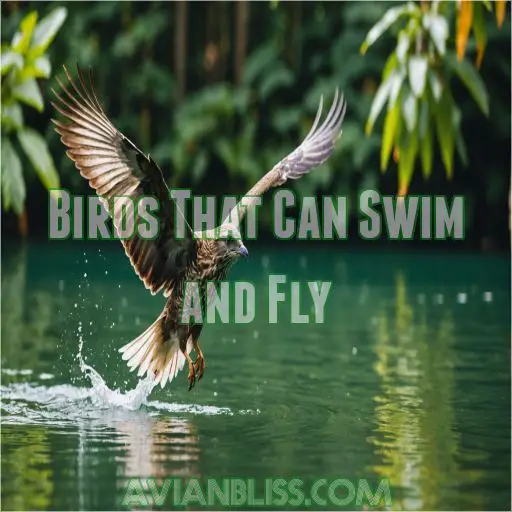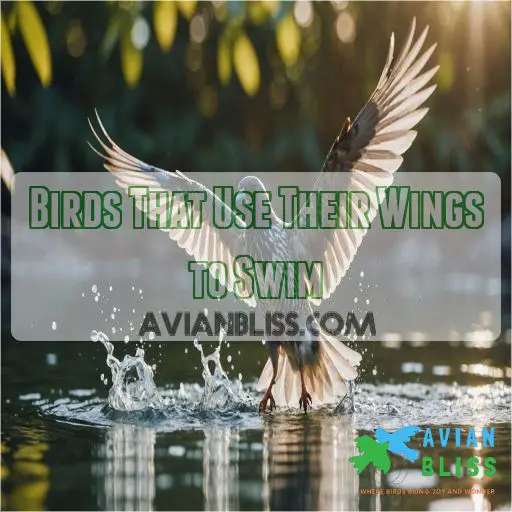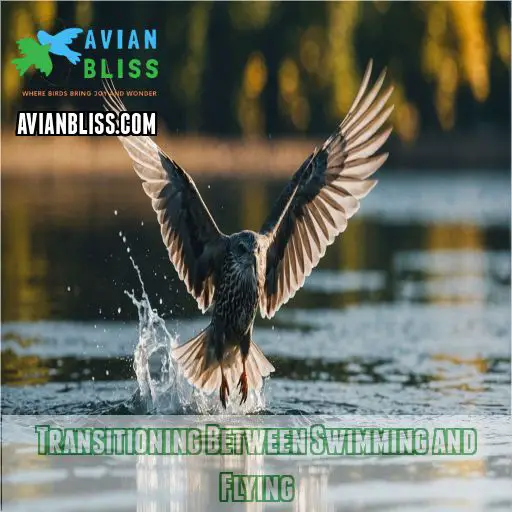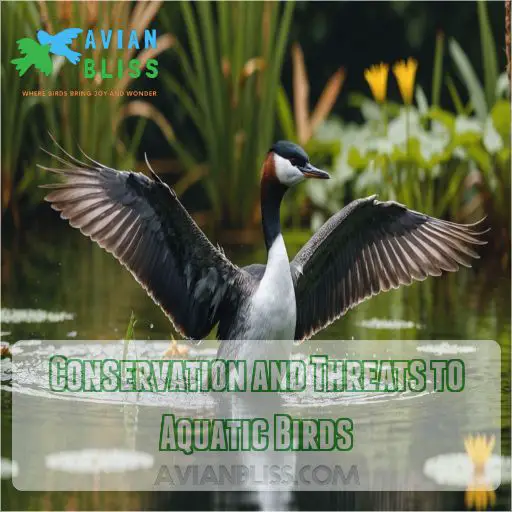This site is supported by our readers. We may earn a commission, at no cost to you, if you purchase through links.

Puffins, pelicans, and ducks are masters of both domains. Why do these birds make such a splash? They’re fitted with webbed feet like flippers, waterproof feathers like raincoats, and sleek, streamlined bodies that cut through water like a hot knife through butter.
Their powerful chest muscles act like turbo boosters for swift take-offs. Curious about how these bird athletes pull off such an extraordinary balancing act? Stick around to discover the secrets behind their versatile skills!
Their bodies are designed to thrive in two very different environments – a true marvel of nature’s engineering.
Table Of Contents
- Key Takeaways
- Birds That Can Swim and Fly
- Swimming Techniques Used by Birds
- Birds That Use Their Wings to Swim
- Birds That Can Only Fly From Water
- The Best Swimmers Among Flying Birds
- Transitioning Between Swimming and Flying
- Conservation and Threats to Aquatic Birds
- Frequently Asked Questions (FAQs)
- Are there birds that can fly and swim?
- Which bird uses its wings to swim?
- What birds can only fly from water?
- What flying bird is the best swimmer?
- How do birds develop waterproof feathers naturally?
- What evolutionary traits enable birds to swim?
- How do birds maintain warmth in cold waters?
- What adaptations allow birds to dive deeply?
- How does bird coloration affect swimming habits?
- Conclusion
Key Takeaways
- Adaptations in Nature: You won’t believe how uniquely equipped these birds are—like wearing a wetsuit made of feathers. Webbed feet act as tiny oars, waterproof feathers keep them dry, and streamlined bodies help them glide through water like hydrodynamic pros.
- Dual Talent Performance: Meet the creatures who master both the sky and the sea, from penguins to puffins. It’s like having a pilot’s license and a scuba diving certificate. Their chest muscles propel them into the air, while their swimming techniques let them dive deep for the catch.
- Survival Challenges: These feathered athletes face real hurdles, from the perils of climate change to the risk of habitat destruction. It’s a high-stakes game of survival—think navigating an obstacle course while your GPS keeps rerouting you.
- Conservation Counts: Your involvement can help protect these incredible creatures. Whether it’s supporting habitat preservation or participating in local conservation efforts, you can play a part in ensuring these birds continue to soar and splash for generations to come.
Birds That Can Swim and Fly
You might think all birds are either aerial acrobats or water specialists, but some extraordinary species master both flying and swimming.
Imagine puffins and pelicans—nature’s multitaskers—soaring through the sky and splashing into the water with equal ease.
Unique Characteristics of Aquatic Birds
Throughout the natural world, certain birds possess a remarkable ability to effortlessly move between the skies and the waters.
These aquatic avians have evolved specialized adaptations, from webbed feet and waterproof feathers to streamlined bodies and powerful chest muscles, enabling them to excel at both swimming and flying.
Their diverse behaviors, from plunge-diving to wing-propelled underwater exploration, showcase nature’s ingenious designs.
Examples of Birds That Can Swim and Fly
In the realm of aquatic birds, some species defy expectations with their dual abilities.
Get ready to explore the fascinating lives of birds that can swim and fly:
- Puffins: Miniature clowns of the sea.
- Cormorants: Masters of deep dives.
- Ducks: Feathered nomads.
- Loons: Ghostly lake dwellers.
- Gulls: Coastal scavengers and acrobats.
These water birds showcase impressive adaptations for aquatic life.
Adaptations for Swimming and Flying
Many flying birds have fascinating feather adaptations and wing morphology due to evolutionary pressures.
Picture a bird cloaked in a feathered wetsuit, zipping through aquatic environments!
This reduces energy expenditure and aids in bird behavior across different habitats.
Imagine the majesty of flight combined with streamlined swimming—it’s like having a driver’s license and a pilot’s license at the same time!
Comparison of Swimming and Flying Abilities
Your exploration of nature’s wonders brings you to compare the energy efficiency and prowess of birds that swim and fly. You’ll find that:
- Ducks exhibit impressive speed differences and maneuverability.
- Pelican’s takeoff strategies are poetry in motion.
- Puffins boast wing adaptations for soaring and gliding.
- Loons conquer coastal areas with unique bird foraging techniques.
Isn’t nature’s playbook a delightful read?
Swimming Techniques Used by Birds
Explore the fascinating world of birds that have mastered the art of swimming.
From the wing-propelled penguins to the foot-powered loons, these aquatic avians showcase a remarkable array of specialized techniques that allow them to thrive both above and below the water’s surface.
Wing-Propulsion in Penguins and Auks
Wing-propulsion when penguins and auks take to water like a flying squirrel. Penguins, with their streamlined bodies and powerful chest muscles, glide through lakes and ponds.
Auks’ wing evolution helps swimming efficiency and underwater agility.
Ever thought oil glands could aid flying? They keep feathers sleek.
| Feature | Penguin | Auk |
|---|---|---|
| Wing Structure | Flipper-like | Compact |
| Underwater Agility | High | Moderate |
| Swimming Efficiency | Superior | Efficient |
Foot-Propulsion in Loons and Grebes
If you’ve ever seen loons and grebes in action, they’re like Olympic swimmers using foot-propulsion with unmatched efficiency.
With webbed feet perfectly evolved for aquatic locomotion, they paddle powerfully beneath the water’s surface.
These birds elegantly foray across the water, propelled by evolutionary adaptations, making you wonder if there’s a race secretly happening underwater.
Talk about mastering propulsion efficiency.
Plunge-Diving in Gannets and Kingfishers
Plunge-diving birds like gannets and kingfishers have mastered the art of high-speed diving. You can picture them diving gracefully, speedometer ticking:
- Diving speed and depth: Up to 100 km/h.
- Genetic adaptations for plunge-diving: Reinforced skulls for impact safety.
- Tau protein protection: Guards nerves against pressure damage.
These daredevils conquer both air and sea, defying gravity!
Specialized Swimming Techniques in Different Species
Variety is indeed the spice of life, and birds utilizing specialized swimming techniques prove it!
Whether it’s diving mechanics or foot-paddling skills, each bird excels in underwater aerodynamics and propulsion strategies.
Who knew aquatic maneuverability could be like an art form?
Here’s a handy table of these avian swimmers:
| Bird | Technique |
|---|---|
| Penguins | Wing-Propulsion |
| Auks | Wing-Propulsion |
| Grebes | Foot-Propulsion |
| Cormorants | Foot-Propulsion |
Birds That Use Their Wings to Swim
You’ll find that some birds cleverly use their wings to swim, like aquatic ninjas in the water.
They paddle through the depths with the same grace they exhibit in the air, showcasing nature’s exceptional dual-purpose engineering.
Penguins and Their Streamlined Bodies
When you think of streamlined efficiency, penguins are the masters.
They’ve got bodies perfectly crafted for aquatic agility, zipping through the water like little tuxedoed torpedoes.
Every aspect, from their smooth, tapered shape to those sturdy flippers, allows for incredible swimming dynamics and drag reduction.
Penguins mightn’t fly in the sky, but underwater, they’re the Olympic swimmers of the bird world, showcasing their aquatic agility.
Auks and Their Adaptations for Diving
Auks are nature’s masters of dual environments, seamlessly shifting from aerial to aquatic domains.
Their diving mechanics are finely tuned, allowing energy efficiency in pursuit of prey.
With buoyancy control and depth adaptation, auks effortlessly navigate the watery world.
It’s like they’ve got the best of both wings and fins, becoming aquatic acrobats in the blink of an eye.
Guillemots and Razorbills as Skilled Swimmers
Guillemots and razorbills dance elegantly through the water, their wings doubling as powerful paddles.
Like underwater acrobats, these birds chase fish, showcasing their expert swimming skills.
They adapt seamlessly between flying and swimming, powered by unique wing structures.
Nature’s multitaskers, they’re remarkably exceptional in their ability to provide exceptional parental care while maneuvering both air and sea environments.
Other Birds That Use Wing-Propulsion
Beyond Guillemots and Razorbills, the Anhinga’s a bit of a show-off regarding wing-propulsion, using its elongated neck to spear food.
Cormorants are all about diving and show remarkable agility underwater.
Ever seen a Puffin in action? Their high-speed propulsion is likened to a jet ski.
These seabird adaptations make them not just survivors, but stars of both sea and sky.
Birds That Can Only Fly From Water
Imagine you’ve got wings but need a push to get airborne; that’s the life of certain aquatic birds like loons and grebes.
They rely on a watery runway to take off, combining determination with a splash of humor as they paddle furiously to lift off.
Loons and Their Limited Takeoff Abilities
Loons, those sleek waterbirds, are often humorously considered the "slow starters" of the avian world due to their takeoff distance requirements.
Their hefty body mass and need for speed on the water surface highlight biological limitations.
Imagine needing a runway on water! Loons can’t easily leap into flight; it’s like they paddle into the air, considering speed factors during takeoff.
They have a unique way of taking off, which is often described as paddling into the air, highlighting their takeoff distance requirements.
Grebes and Their Webbed Feet
While loons may struggle to lift off, grebes have their own unique charm.
Picture those webbed feet—they’re not just for show! Grebes use them for:
- Efficient paddling through water
- Precise maneuvering with toe adaptations
- Masterful diving technique
- Maintaining feather waterproofing
Think of them as nature’s mini jet skis, zipping about with grace!
Cormorants and Their Unique Takeoff Methods
Unlike loons, cormorants have a unique takeoff strategy from the water.
These sleek, black seabirds use their powerful webbed feet to propel themselves across the surface, flapping their wings vigorously to generate enough lift for an airborne escape.
Their agile aquatic flight techniques allow them to effortlessly shift between swimming and soaring.
Other Birds With Limited Takeoff Abilities
Cormorants have intriguing takeoff methods from water, and some birds like heavy winged loons face similar challenges.
Imagine trying to lift off a pond with DNA changes in evolution creating heavy wing loading. These birds need unique takeoff strategies, using leg-wing force shift like a sprinter.
For them, flightless adaptations don’t mean they’re grounded—just creatively aerial.
The Best Swimmers Among Flying Birds
Some birds are true masters of the water, effortlessly gliding and diving with unparalleled grace.
From penguins to loons, these aquatic champions showcase remarkable adaptations that allow them to thrive in both the air and the depths below.
Characteristics of Excellent Swimmers
You’ve just explored birds with limited takeoff abilities, now let’s float into the world of amazing swimmers.
Think Ferrari in feather form.
Wing adaptations that sweep you off your feet, buoyancy features for ocean floor excursions, and streamlined anatomy make these avian athletes masters in propulsion techniques.
Their hydrodynamic efficiency allows seamless shifts between sky-high flights and plunges, outswimming underwater ballet schools.
Examples of Birds With Exceptional Swimming Abilities
Just explored the top swimmers? Now, discover birds that excel in both flying and swimming:
- Penguins use flippers for agile deep-diving and comically waddle on land—nature’s tuxedo-clad torpedoes!
- Loons paddle gracefully, their haunting cries echoing over still waters.
- Auks mimic underwater flight paths, showing off their versatile moves.
- Flying fish astound with their acrobatics, cruising over waves effortlessly.
Adaptations for Efficient Swimming
Aquatic birds have remarkable adaptations that make them efficient swimmers, like waterproof feathers. Their waterproof feathers, streamlined bodies, and powerful webbed feet propel them through the water with ease. Flexible necks and specialized wing structures further enhance their aquatic prowess, allowing them to dive deep and maneuver gracefully underwater.
| Adaptation | Purpose |
|---|---|
| Waterproof Feathers | Repel water, maintain insulation |
| Streamlined Bodies | Reduce drag, increase speed |
| Webbed Feet | Provide powerful propulsion |
| Flexible Necks | Improve underwater visibility and agility |
| Specialized Wings | Generate lift and thrust in water |
Comparison of Swimming Abilities in Different Species
In terms of swimming efficiency, birds have a fascinating spectrum of abilities.
Some species excel, like penguins who race through water with wing propulsion, booking it at speeds up to 25 mph.
Others, like loons, rely on powerful feet for deeper dives.
The dance between water resistance and speed comparisons reveals nature’s brilliant adaptations for both wings and feet underwater.
Transitioning Between Swimming and Flying
When you explore the fascinating world of birds that swim and fly, you’ll find they showcase incredible feats of adaptability worthy of nature’s best multitaskers.
Birds like ducks and puffins flaunt their webbed feet, waterproof feathers, streamlined bodies, and more, effortlessly switching between air and water like a daredevil circus act—without the tightrope, of course!
Webbed Feet and Waterproof Feathers
You’ll be amazed by the ingenious adaptations that allow birds to effortlessly move between swimming and flying. For starters, their webbed feet act like tiny oars, propelling them through the water with ease. Plus, their feathers are coated in a waterproofing oil that repels moisture, keeping them dry and buoyant.
- Webbed feet provide superior swimming power.
- Waterproof feathers prevent waterlogging.
- Oil glands maintain feather structure and insulation.
Streamlined Bodies and Powerful Chest Muscles
While talking about webbed feet and waterproof feathers, don’t forget streamlined bodies and muscle power.
Just as an aerodynamic car zips through air, birds’ sleek shapes cut water and air, boosting swimming efficiency.
Strong chest muscles drive both swimming and flight, providing adaptability between environments.
This clever design mirrors nature’s own engineering marvel, blending form and function like a master chess player.
Flexible Necks and Specialized Wings
With streamlined bodies powered by strong muscles, our feathered friends don’t stop there.
Birds also boast flexible necks and specialized wings. These adaptations are like nature’s Swiss Army knife, enhancing underwater maneuverability and flight efficiency.
Evolutionary pressures have fine-tuned them, allowing these aerial and aquatic masters to switch from the ocean’s depths to sky’s heights effortlessly, displaying their remarkable flight efficiency.
Techniques for Taking Off From Water
Effortlessly moving between the water and sky, birds employ a variety of ingenious techniques to take flight. From the powerful running start of ducks and geese, to the wing-assisted leap of swans, these aerial masters showcase their adaptability. Webbed feet provide the thrust needed to build momentum, while specialized wings generate the lift for a graceful takeoff.
- Running Takeoff: Birds paddle aggressively with their webbed feet to build up speed on the water’s surface, then spread their wings and take to the air.
- Wing-Assisted Leap: Some birds, like swans, use a combination of flapping their wings and pushing off the water to propel themselves into the sky.
- Foot-Propelled Liftoff: Loons and grebes can take off directly from the water by using their powerful feet to push themselves up and into the air. Conservation and Threats to Aquatic Birds
Conservation and Threats to Aquatic Birds
You mightn’t think twice about a bird that swims and flies, but these incredible creatures face serious threats every day.
From habitat destruction to climate change, we’re all hoping they can adapt faster than a penguin chasing a fish.
Habitat Destruction and Pollution
Battling pollution effects, aquatic birds face habitat fragmentation and resource scarcity, leading to biodiversity decline.
Imagine your home shrinking overnight or your food disappearing—sounds like a real pickle, right?
Conservation strategies are essential for these feathered friends, offering freedom to thrive rather than just survive.
By protecting their habitats, we’re giving birds a fighting chance to keep soaring and swimming. It is crucial for their survival and well-being.
We must prioritize the well-being of aquatic birds, providing them a suitable environment to live in, and by doing so, we are giving them a fighting chance.
Climate Change and Its Effects on Aquatic Birds
Climate change throws some birds into a tailspin! Aquatic birds face hurdles like seabird food scarcity and rising sea levels.
You might think birds have it easy with flying, but ocean acidification effects keep them guessing!
Their migration pattern changes and new morphological adaptations are just part of staying ahead in a world morphing faster than a chameleon changing colors.
Hunting and Poaching of Aquatic Birds
Many aquatic birds face dangers from hunting and poaching. This illegal trade impacts their survival, highlighting species vulnerability.
You might imagine birds attempting to outrun poachers, but it’s no laughing matter.
Strong law enforcement and anti-poaching strategies are essential. Conservation funding backs these efforts, aiming to safeguard our feathered friends.
Let’s make sure they continue to soar and swim freely!
Conservation Efforts and Protection of Aquatic Birds
You can be a hero in preserving our feathered friends’ habitats.
Engaging in Indigenous stewardship and aquatic habitats restoration can protect these marvelous birds.
Support endangered species protection by funding local wildlife organizations.
Embrace pollution mitigation strategies and climate resilience initiatives—together, we can make certain these birds soar and swim for generations.
Let’s spread wings and hope!
Frequently Asked Questions (FAQs)
Are there birds that can fly and swim?
Yes, there are birds that can both swim and fly!
These remarkable creatures have evolved unique adaptations, like webbed feet and waterproof feathers, allowing them to seamlessly move between the air and water. (Source)
Which bird uses its wings to swim?
Like a fish out of water, penguins use their wings to swim.
Though they can’t fly, they move gracefully underwater with their flipper-like wings, propelling themselves efficiently as if they’re on a sleek, aquatic dance.
What birds can only fly from water?
Loons, with their streamlined bodies and powerful legs, must take off from water.
They paddle furiously, wings flapping, like a plane on a runway, eventually lifting off.
Their unique technique is nature’s little runway show.
What flying bird is the best swimmer?
You’re kidding, right?
The penguin—a bird that forgot about flying—wins the swimming race hands down.
With flippers, sleek bodies, and speed up to 25 mph, they could rival any fish in aquatic acrobatics!
How do birds develop waterproof feathers naturally?
Birds naturally develop waterproof feathers through specialized glands near their tails, producing oils that coat their feathers to keep them dry.
This marvel of nature helps feathers repel water, ensuring they don’t get bogged down like a soggy sponge.
It’s ingenious!
What evolutionary traits enable birds to swim?
Evolution gifted birds with webbed feet, waterproof feathers, and buoyant bodies, turning them into nature’s aqua acrobats.
These adaptations let them dive like Olympians and paddle like pros, blending freedom of flight with aquatic agility.
How do birds maintain warmth in cold waters?
Like a cozy quilt in winter, specialized feathers keep avian swimmers warm.
They’ve got natural oils for waterproofing, trap insulating air, and maintain warmth even in icy waters, letting birds plunge into chilly depths without freezing.
What adaptations allow birds to dive deeply?
You’d be amazed by the deep-diving prowess of some birds!
Their streamlined bodies, powerful wings, and flexible necks allow them to plunge into the depths, snatching up tasty underwater treats with ease.
It’s truly a marvel of avian adaptation.
How does bird coloration affect swimming habits?
Bird coloration, with its dazzling hues, can impact swimming habits by aiding camouflage or attracting mates.
Vibrant colors might tempt a predator’s appetite while muted shades help in blending with watery backgrounds, enhancing survival chances underwater.
Conclusion
Amazingly, about 8% of bird species are aquatic, showcasing the idea that birds that can swim and fly have mastered both domains.
You’ve explored how their webbed feet and waterproof feathers enable them to thrive in diverse environments, from the slick dive of a penguin to the majestic plunge of a gannet.
Imagine defying gravity with such ease! While these birds face challenges like habitat loss, conservationists are working hard to preserve these masters of dual worlds.









